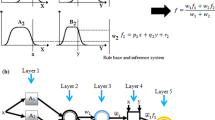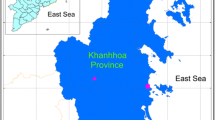Abstract
Drought causes huge losses in agriculture and has many negative influences on natural ecosystems. In this study, the applicability of Adaptive Neuro-Fuzzy Inference System (ANFIS) for drought forecasting and quantitative value of drought indices, the Standardized Precipitation Index (SPI), is investigated. For this aim, 10 rainfall gauging stations located in Central Anatolia, Turkey are selected as study area. Monthly mean rainfall and SPI values are used for constructing the ANFIS forecasting models. For all stations, data sets include a total of 516 data records measured between in 1964 and 2006 years and data sets are divided into two subsets, training and testing. Different ANFIS forecasting models for SPI at time scales 1–12 months were trained and tested. The results of ANFIS forecasting models and observed values are compared and performances of models were evaluated. Moreover, the best fit models have been also trained and tested by Feed Forward Neural Networks (FFNN). The results demonstrate that ANFIS can be successfully applied and provide high accuracy and reliability for drought forecasting.





Similar content being viewed by others
References
Agarwal A, Mishra SK, Ram S, Singh JK (2006) Simulation of runoff and sediment yield using artificial neural networks. Biosyst Eng 94(4):597–613
Altunkaynak A, Özger M, Çakmakcı M (2005) Water consumption prediction of Istanbul City by using fuzzy logic approach. Water Resour Manage 19:641–654
ASCE Task Committee (2000) Artificial neural networks in hydrology. II. Hydrologic applications. J Hydrol Eng ASCE 5(2):124–137
Bonaccorso B, Bordi I, Cancielliere A, Rossi G, Sutera A (2003) Spatial variability of drought: an analysis of the SPI in Sicily. Water Resour Manage 17:273–296
Byun HR, Wilhite DA (1999) Objective quantification of drought severity and duration. J Clim 12:2747–2756
Cancelliere A, Di Mauro G, Bonaccorso B, Rossi G (2007) Drought forecasting using the standardized precipitation index. Water Resour Manage 21:801–819
Chang FJ, Chang YT (2006) Adaptive neuro-fuzzy inference system for prediction of water level in reservoir. Adv Water Resour 29:1–10
Chou FNF, Chen BPT (2007) Development of drought early warning index: using neuro-fuzzy computing technique. In: 8th international symposium on advanced intelligence systems 2007, Korea. Paper No:A1469
Dracup JA, Lee KS, Paulson EG (1980) On the statistical characteristics of drought events. Water Resour Res 16:289–296
Edwards DC, McKee TB (1997) Characteristics of 20th century droughts in the United States at multiple time scales. Climatology Report, 97–2, Department of Atmospheric Sciences, Colorado State University, Fort Collins, CO, pp 155
Firat M (2007) Watershed modeling by adaptive Neuro-fuzzy inference system approach, Doctor of Philosophy Thesis, Pamukkale University, Turkey (in Turkish)
Firat M, Güngör M (2007) River flow estimation using adaptive neuro-fuzzy inference system. Math Comput Simul 75(3–4):87–96
Firat M, Güngör M (2008) Hydrological time-series modeling using adaptive neuro-fuzzy inference system. Hydrol Process 22(13):2122–2132
Guttmann NB (1998) Comparing the Palmer drought index and the standardized precipitation index. J Am Water Resour Assoc 34:113–121
Hayes M (1997) Drought indices, p 11. Available at: www.drought.unl.edu
Hayes MJ (2000) Revisiting the SPI: Clarifying the Process. Drought Network News, A Newsletter of the International Drought Information Center and the National Drought Mitigation Center 12/1 (Winter 1999–Spring 2000), 13–15
Hayes MJ, Svoboda MD, Wilhite DA, Vanyarkho OV (1999) Monitoring the 1996 drought using the standardized precipitation index. Bull Am Meteorol Soc 80:429–438
Hughes BL, Saunders MA (2002) A drought climatology for Europe. Int J Climatol 22:1571–1592
Jain A, Kumar AM (2007) Hybrid neural network models for hydrologic time series forecasting. Appl Soft Comput 7:585–592
Jang JSR, Sun CT, Mizutani E (1997) Neuro-fuzzy and soft computing. Prentice Hall, Englewood Cliffs, NJ, USA, 607pp. ISBN 0-13-261066-3
Jeong D, Kim YO (2005) Rainfall-runoff models using artificial neural networks for ensemble stream flow prediction. Hydrol Process 19:3819–3835
Keyantash J, Dracup J (2002) The quantification of drought: an evaluation of drought indices. Bull Am Meteorol Soc 83:167–118
Kumar ARS, Sudheer KP, Jain SK, Agarwal PK (2005) Rainfall-runoff modelling using artificial neural networks: comparison of network types. Hydrol Process 19:1277–1291
Liong SY, Lim WH, Kojiri T, Hori T (2000) Advance flood forecasting for flood stricken Bangladesh with a fuzzy reasoning method. Hydrol Process 14:431–448
Mahabir C, Hicks FE, Fayek AR (2000) Application of fuzzy logic to the seasonal runoff. Hydrol Process 17:3749–3762
Mantoglou A (2003) Estimation of heterogeneous aquifer parameters from piezometric data using ridge functions and neural networks. Stoch Environ Res Risk Assess 17:339–352
McKee TB, Doesken NJ, Kleist J (1993) The relationship of drought frequency and duration to time steps. Preprints, 8th Conference on Applied Climatology, January 17–22 Anaheim, California, pp 179–184
McKee TB, Doesken NJ, Kleist J (1995) Drought monitoring of climate. Geogr Rev 38:55–94
Mishra AK, Desai VR (2005) Drought forecasting using stochastic models. Stoch Environ Res Risk Assess 19:326–339
Mishra AK, Desai VR (2006) Drought forecasting using feed-forward recursive neural network. Ecol Model 198:127–138
Mishra AK, Singh VP, Desai VR (2008) Drought characterization: a probabilistic approach. Stoch Environ Res Risk Assess (in press). doi:10.1007/s00477-007-0194-2
Moreira EE, Paulo AA, Pereira LS, Mexia JT (2006) Analysis of SPI drought class transitions using loglinear models. J Hydrol 331:349–359
Morid S, Smakhtin V, Bagherzadeh K (2007) Drought forecasting using artificial neural networks and time series of drought indices. Int J Climatol 27:2103–2111
Nagy HM, Watanabe K, Hirano M (2002) Prediction of sediment load concentration in rivers using artificial neural network model. J Hydr Eng 128:588–595
Nayak PC, Sudheer KP, Rangan DM, Ramasastri KS (2004) A Neuro Fuzzy computing technique for modeling hydrological time series. J Hydrol 291:52–66
Nayak PC, Sudheer KP, Ramasastri KS (2005) Fuzzy computing based rainfall-runoff model for real time flood forecasting. Hydrol Process 19:955–968
Nicholson SE, Davenport ML, Malo AR (1990) A comparison of the vegetation response to rainfall in the Sahel and east Africa, using normalized difference vegetation index from NOAA-AVHRR. Clim Change 17(2–3):209–241
Ntale HK, Gan T (2003) Drought indices and their application to East Africa. Int J Climatol 23:1335–1357
Palmer WC (1965) Meteorological drought. US Weather Bureau Research Paper 45. Washington, DC
Palmer WC (1995) Meteorological Drought. Research Paper, US
Pickup G (1998) Desertification and climate change – the Australian perspective. Clim Res 11:51–63
Rajurkar MP, Kothyari UC, Chaube UC (2004) Modeling of the daily rainfall-runoff relationship with artificial neural network. J Hydrol 285:96–113
Sırdaş S, Şen Z (2003) Spatio-temporal drought analysis in the Trakya region, Turkey. Hydrol Sci 48(5):809–820
Şen Z (2001) Fuzzy logic and foundation. BKS Publisher, 172pp. ISBN: 9758509233 (in Turkish)
Şen Z, Altunkaynak A (2006) A comparative fuzzy logic approach to runoff coefficient and runoff estimation. Hydrol Process 20:1993–2009
Wilhite DA (1997) A methodology for drought preparedness. Nat Hazards 13:229–252
Wu JD, Li N, Yang HJ, Li CH (2008) Risk evaluation of heavy snow disasters using BP artificial neural network: the case of Xilingol in Inner Mongolia. Stoch Environ Res Risk Assess (in press). doi:10.1007/s00477-007-0181-7
Vicente-Serrano SM, Lopez-Moreno JI (2005) Hydrological response to different time scales of climatological drought: an evaluation of the Standardized Precipitation Index in amountainous Mediterranean basin. Hydrol Earth Syst Sci 9:523–533
Zadeh LA (1965) Fuzzy sets. Inf Control 8(3):338–353
Acknowledgments
The authors are grateful for editors and anonymous reviewers for their helpful and constructive comments on an earlier draft of this paper.
Author information
Authors and Affiliations
Corresponding author
Rights and permissions
About this article
Cite this article
Bacanli, U.G., Firat, M. & Dikbas, F. Adaptive Neuro-Fuzzy Inference System for drought forecasting. Stoch Environ Res Risk Assess 23, 1143–1154 (2009). https://doi.org/10.1007/s00477-008-0288-5
Published:
Issue Date:
DOI: https://doi.org/10.1007/s00477-008-0288-5




